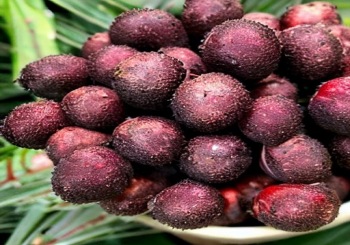What is a Saw Palmetto Berry?
A saw palmetto berry is the fruit of the saw palmetto plant (Serenoa repens), which is a small palm tree native to the southeastern United States, particularly the coastal regions of Florida. The berries are small, round, and typically dark purple to black when ripe. A thin, fleshy outer layer covers the berries that grow in clusters..
Saw palmetto berries have been traditionally used by Native American tribes for medicinal purposes, particularly in relation to prostate health and urinary symptoms. Bioactive compounds like fatty acids, phytosterols, flavonoids, and triterpenes are present in the berries and are thought to be responsible for their potential health benefits..
Saw palmetto berries possess a powerful aroma and bitter taste. They are typically processed before consumption because their raw form can be unpalatable due to taste and texture.
Saw palmetto berries have gained popularity as a natural remedy and are commonly used to produce extracts, powders, capsules, and liquid formulations for dietary supplements or herbal preparations. These products are often standardized to ensure consistent levels of key bioactive compounds, allowing for more accurate dosing.
It’s recommended to use saw palmetto berries and their products with caution and under the guidance of a healthcare professional, particularly if you have any pre-existing medical conditions or are taking medications. Seeking advice from a healthcare professional or herbalist can help determine the correct use and dosage of saw palmetto berries for your unique health needs.
Can You Eat Saw Palmetto Berries?
As mentioned above, raw saw palmetto berries are generally considered inedible due to their strong and bitter taste. The berries contain high levels of fatty acids and other compounds that contribute to their distinct flavor. Plus, eating raw berries directly may cause stomach discomfort or gastrointestinal issues for some individuals.
Most commercially available saw palmetto products are in the form of standardized extracts, powders, capsules, or liquid formulations.
So, the berries are edible but they are probably not something you’d want to eat regularly. Better to stick with consuming processed berries.
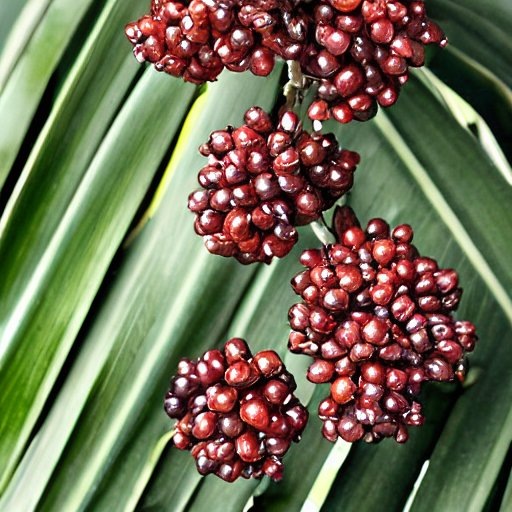
Benefits of Saw Palmetto Berries
Historical Context –
Saw palmetto berries have a rich history of traditional use among Native American tribes, such as the Seminole and Miccosukee peoples. These tribes recognized the therapeutic properties of the berries and used them to treat urinary and reproductive issues, improve vitality, and support overall well-being.
Traditional Medicinal Uses –
The Native American tribes traditionally utilized saw palmetto berries to alleviate urinary symptoms associated with benign prostatic hyperplasia (BPH), a non-cancerous enlargement of the prostate gland. The berries were also used to address reproductive disorders, boost libido, treat respiratory conditions, and support the urinary tract.
Modern Scientific Interest –
In recent decades, saw palmetto berries have attracted significant attention from researchers, scientists, and medical professionals due to their potential therapeutic properties. Numerous studies have been conducted to explore their chemical composition, mechanisms of action, and potential health benefits.
Prostate Health –
One of the primary areas of interest regarding saw palmetto berries is their impact on prostate health. Clinical studies have suggested that saw palmetto extract may help reduce urinary symptoms associated with BPH, such as frequent urination, weak urine flow, and nighttime urination. It is believed that the bioactive compounds present in the berries inhibit the conversion of testosterone to dihydrotestosterone (DHT), a hormone involved in the development of prostate enlargement.
Urinary Tract Symptoms –
In addition to prostate health, saw palmetto berries have been investigated for their potential to alleviate urinary tract symptoms in both men and women. Research suggests that the berries’ anti-inflammatory and anti-androgenic properties may contribute to reducing urinary frequency, urgency, and discomfort.
Other Potential Benefits –
Beyond urinary and reproductive health, saw palmetto berries have been studied for their potential in managing hormonal imbalances, promoting hair growth, and addressing certain inflammatory conditions. While further research is needed to fully understand these effects, initial findings have shown promise.
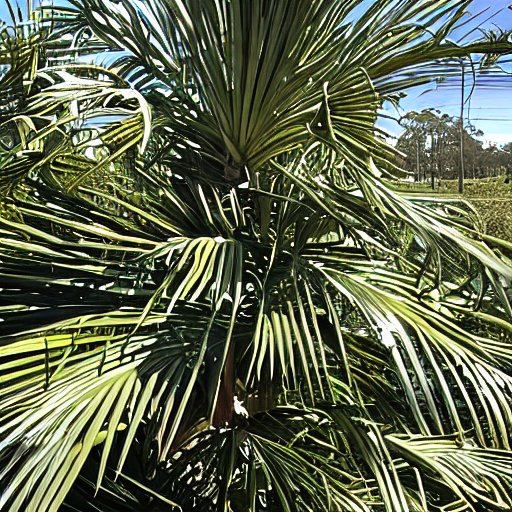
Saw Palmetto Berries vs. Extract
The choice between consuming saw palmetto berries or an extract of the berries depends on several factors, including convenience, dosage accuracy, and personal preference. Both options can provide health benefits, but they have some differences worth considering.
Whole Saw Palmetto Berries
Pros –
- Natural form: Consuming whole berries allows you to experience the fruit in its natural state.
- Potential synergy: Whole berries contain a combination of bioactive compounds, which may have synergistic effects.
Cons –
- Taste and texture: Raw saw palmetto berries have a strong and bitter taste, which some people find unpleasant.
- Dosage control: It can be challenging to determine the exact dosage of bioactive compounds in whole berries, as the concentration can vary.
- Availability: Fresh saw palmetto berries may not be readily available, depending on your location and the season.
Saw Palmetto Extracts
Pros –
- Standardized dosage: Extracts are often standardized to contain specific levels of bioactive compounds, ensuring consistent dosing.
- Concentrated form: Extracts typically contain higher concentrations of the beneficial compounds found in saw palmetto berries.
- Convenience: Extracts are available in various forms, such as capsules, tablets, or liquid formulations, making them easy to incorporate into a daily routine.
Cons –
- Processing: Extracts undergo processing, which may involve the use of solvents or other extraction methods that could impact the overall composition.
- Potential loss of synergistic effects: While extracts concentrate specific compounds, they may not capture the full range of bioactive compounds present in the whole berries.
Ultimately, the decision depends on personal preference and the specific health benefits you are seeking. If you prefer a natural and whole-food approach, consuming raw saw palmetto berries may be an option. However, if you prefer standardized dosing and convenience, saw palmetto extracts may be a more suitable choice. It’s important to consult with a healthcare professional or herbalist who can provide guidance on the appropriate dosage and form of saw palmetto based on your specific needs and health conditions.
Saw Palmetto Berries For Sale
Where can you find saw palmetto berries for sale? Saw palmetto berries can be found for sale at various places, both online and offline. Here are some common options for purchasing saw palmetto berries:
- Health Food Stores: Local health food stores or natural food markets often carry a selection of dried herbs, including saw palmetto berries. You can visit stores in your area to check if they have saw palmetto berries available.
- Online Retailers: Many online retailers specialize in selling herbs, botanicals, and dietary supplements. You can search for “saw palmetto berries for sale” or “buy saw palmetto berries” on popular e-commerce platforms or health-focused websites to find options for purchasing them online. Be sure to research the credibility and reputation of the seller before making a purchase.
- Herbal Suppliers and Wholesalers: Some suppliers and wholesalers specialize in providing bulk herbs, including saw palmetto berries, to individuals, businesses, and manufacturers. These suppliers may have minimum order requirements or cater to wholesale customers, so it’s important to check their terms and conditions.
- Farmers’ Markets and Local Growers: If you live in an area where saw palmetto grows, you may find fresh or dried saw palmetto berries at local farmers’ markets or directly from local growers. This option provides an opportunity to support local producers and ensures fresh, locally sourced berries.
- Herbalists and Traditional Medicine Practitioners: Herbalists, traditional medicine practitioners, or naturopaths may have access to or recommendations on where to source high-quality saw palmetto berries. They can guide you on the best places to obtain the berries based on their expertise and knowledge of the local market.
When purchasing saw palmetto berries, it’s important to consider factors such as quality, sustainability, and ethical sourcing. Look for reputable sellers who prioritize quality control, sustainable harvesting practices, and adhere to relevant regulations and certifications.
Technical Information On Saw Palmetto Berries
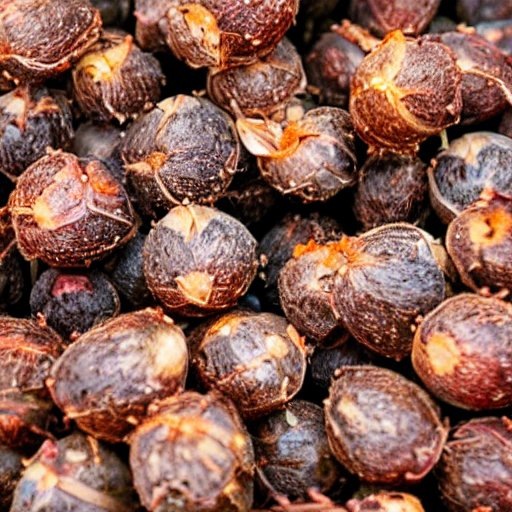
Botanical Description of Saw Palmetto Berries
Taxonomy and Botanical Classification –
Saw palmetto, scientifically known as Serenoa repens, belongs to the family Arecaceae, which is the palm family. It is a small palm tree that typically grows up to 2-4 meters (6-13 feet) in height. The plant features a cluster of fan-shaped leaves and produces dark purple to black berries.
Morphological Characteristics –
Trunk: Saw palmetto has a creeping trunk that lies horizontally along the ground, sending out suckers to form clumps or thickets. The trunk is typically covered in fibrous leaf bases that give it a rough texture.
Leaves: The leaves of saw palmetto are palmate or fan-shaped, with a length ranging from 50 to 100 centimeters (20 to 40 inches). They are divided into multiple leaflets that are arranged in a circular or semi-circular pattern.
Flowers: Saw palmetto produces small, white flowers that are clustered together in branched inflorescences known as panicles. The flowers are typically dioecious, meaning that male and female flowers are borne on separate plants.
Berries: The berries of saw palmetto are spherical or ovoid in shape, measuring approximately 1-2 centimeters (0.4-0.8 inches) in diameter. They start off green and then turn dark purple to black when mature. Each berry contains a single seed.
Geographic Distribution and Habitat –
Geographic Distribution: Saw palmetto is native to the southeastern United States, primarily found in the coastal regions of Florida, Georgia, and other Gulf Coast states. It is also cultivated in some other parts of the world, including Mediterranean countries.
Habitat: Saw palmetto thrives in sandy soils, particularly in coastal dunes, pine flatwoods, and scrub habitats. It is well-adapted to tolerate the harsh conditions of its native environment, including drought, high temperatures, and salt spray.
Chemical Composition and Nutritional Profile
Key Bioactive Compounds –
Fatty Acids: Saw palmetto berries are rich in fatty acids, particularly saturated and monounsaturated fatty acids. The primary fatty acids present include lauric acid, oleic acid, myristic acid, and palmitic acid. These fatty acids contribute to the overall nutritional value of the berries.
Phytosterols: Saw palmetto berries contain various phytosterols, with beta-sitosterol being the most abundant. Phytosterols have been associated with several health benefits, including supporting prostate health and reducing cholesterol levels.
Flavonoids: Saw palmetto berries contain flavonoids, which are plant compounds known for their antioxidant and anti-inflammatory properties. Some of the flavonoids present in the berries include quercetin, kaempferol, and apigenin.
Triterpenes: Saw palmetto berries are also rich in triterpene compounds, such as beta-sitosterol glucoside and lupeol. These triterpenes are believed to contribute to the berries’ potential effects on prostate health and other therapeutic properties.
Nutritional Composition –
Macronutrients: Saw palmetto berries are low in calories and carbohydrates. They contain moderate amounts of dietary fiber and protein. The fat content in the berries, primarily in the form of fatty acids, provides a source of energy.
Vitamins: Saw palmetto berries are a source of various vitamins, although their levels may vary. They contain vitamin E, which acts as an antioxidant, as well as small amounts of vitamin C and vitamin K.
Minerals: Saw palmetto berries contain minerals such as potassium, calcium, magnesium, and phosphorus. The mineral content can vary depending on the soil composition and growing conditions.
Variations in Chemical Composition –
The chemical composition of saw palmetto berries can vary based on several factors, including geographical location, climate, cultivation practices, and extraction methods. It is important to note that commercial saw palmetto extracts often undergo standardized extraction processes to ensure consistent levels of key bioactive compounds.
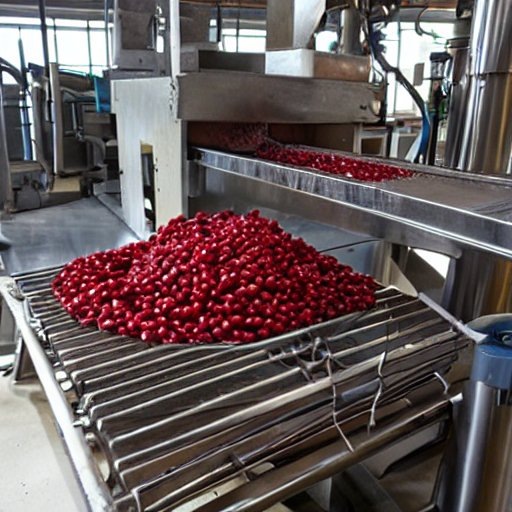
Commercial Cultivation and Harvesting
Cultivation Practices and Growth Requirements –
Climate and Soil: Saw palmetto is adapted to subtropical and warm temperate climates. It thrives in areas with mild winters and hot summers. The plant prefers well-drained sandy soils but can tolerate a range of soil types.
Propagation: Saw palmetto is primarily propagated through seeds. Seeds are collected from mature berries and should be cleaned and processed before planting. Germination can be slow and erratic, requiring a warm and humid environment.
Planting and Spacing: Seedlings or young plants are typically planted in prepared beds or containers. Adequate spacing between plants is important to allow proper growth and airflow.
Maintenance: Saw palmetto requires regular watering, particularly during the establishment phase. Weeds should be managed to prevent competition. Pruning is generally not required, as the plant naturally forms clumps.
Harvesting Techniques and Timing –
Berry Maturity: Saw palmetto berries are harvested when they reach full maturity, typically in the late summer to early fall. The berries transition from green to dark purple to black when ripe.
Harvesting Methods: The harvesting process can vary depending on the scale of cultivation. For small-scale operations, handpicking is often used, where the ripe berries are carefully collected by hand. In larger operations, mechanical harvesting methods may be employed, such as using specialized equipment to shake the berries off the plants.
Post-Harvest Handling: After harvesting, the berries are typically cleaned, sorted, and processed to remove any impurities. They may be dried to reduce moisture content or processed immediately for extraction of bioactive compounds.
Post-Harvest Processing and Preservation Methods –
Drying: Saw palmetto berries can be dried to extend their shelf life and preserve their quality. Drying methods can include air drying, low-temperature drying, or using specialized drying equipment.
Extraction: Saw palmetto berries are often processed to extract the bioactive compounds for various applications. Extraction methods commonly used include solvent extraction, supercritical fluid extraction, or cold pressing.
Storage and Packaging: Proper storage conditions, including cool and dry environments, are essential to maintain the quality of harvested saw palmetto berries. Packaging should provide protection against moisture, light, and oxidation to prevent degradation of the bioactive compounds.
Market Trends and Economic Significance
Global Market Analysis –
Growing Demand: The market for saw palmetto berries and its derived products has witnessed significant growth in recent years. Increasing consumer awareness of natural health remedies and the rising interest in herbal supplements have contributed to the growing demand for saw palmetto products.
Geographic Distribution: The demand for saw palmetto berries and extracts is widespread, with markets in North America, Europe, Asia-Pacific, and other regions. The United States, due to its native range of saw palmetto, remains a prominent market, both for domestic consumption and export.
Market Segmentation: The saw palmetto market is segmented based on product type, including whole berries, standardized extracts, powders, capsules, and liquid formulations. Each segment caters to different consumer preferences and application requirements.
Demand and Supply Dynamics –
Prostate Health and Urinary Supplements: Saw palmetto berries and extracts are primarily consumed as dietary supplements for supporting prostate health and managing urinary symptoms. The demand for natural remedies for benign prostatic hyperplasia (BPH) and other related conditions has contributed to the increased demand for saw palmetto products.
Industry Players: The market consists of various companies involved in the cultivation, processing, and distribution of saw palmetto products. These include herbal supplement manufacturers, pharmaceutical companies, and nutraceutical companies.
Supply Challenges: Meeting the growing demand for saw palmetto berries can be challenging due to factors such as the slow growth rate of the plant, the need for specific climatic conditions, and the limited availability of wild populations. Sustainable cultivation practices and responsible sourcing are essential to ensure a stable supply chain.
Pricing Trends and Value Chain Analysis –
Pricing Factors: The pricing of saw palmetto products is influenced by several factors, including the form of the product (e.g., whole berries, extracts), the concentration of bioactive compounds, the quality and purity of the product, and market competition.
Value Chain: The value chain of saw palmetto berries involves multiple stages, including cultivation, harvesting, processing, extraction, product formulation, packaging, distribution, and retail. Each stage adds value to the product and influences its final pricing.
Economic Significance –
Employment and Income Generation: The commercial cultivation, processing, and trade of saw palmetto berries contribute to the creation of employment opportunities, particularly in regions where the plant is cultivated. This industry supports the livelihoods of farmers, harvesters, processors, and workers involved in various stages of the value chain.
Revenue Generation: The saw palmetto industry represents a significant economic sector, generating revenue through the sale of raw berries, extracts, and finished products. This revenue contributes to regional and national economies, particularly in areas where saw palmetto cultivation is a significant agricultural activity.
Regulatory Status and Quality Control
Legal Status and Regulations –
United States: In the United States, saw palmetto is considered a dietary supplement and falls under the regulations of the Dietary Supplement Health and Education Act (DSHEA) enforced by the U.S. Food and Drug Administration (FDA). This means that manufacturers are responsible for ensuring the safety and labeling accuracy of their products.
International Regulations: The regulations surrounding saw palmetto and its derivatives vary among countries. In some regions, it may be classified as a traditional herbal medicine, while in others, it may be regulated as a dietary supplement or an ingredient in pharmaceutical products. Compliance with local regulations is crucial for manufacturers and suppliers in the global market.
Quality Control Measures and Standards –
Good Agricultural Practices (GAP): Implementing GAP ensures that saw palmetto is cultivated in a manner that promotes sustainable practices, reduces environmental impact, and maintains product quality. This includes aspects such as proper seed selection, cultivation techniques, pest control, and harvest management.
Good Manufacturing Practices (GMP): GMP guidelines establish quality control standards for the manufacturing, processing, packaging, and labeling of dietary supplements, including saw palmetto products. Compliance with GMP regulations helps ensure the consistency, quality, and safety of the final product.
Standardization and Quality Assurance: Standardization of saw palmetto extracts involves determining and maintaining consistent levels of key bioactive compounds, such as fatty acids and phytosterols. Quality control measures may include analytical testing methods, including High-Performance Liquid Chromatography (HPLC) or Gas Chromatography (GC), to assess the composition and purity of the extract.
Certification and Labeling Requirements –
Organic Certification: Saw palmetto cultivation and processing can meet organic certification standards, which ensure that organic farming practices and guidelines are followed. Organic certification may provide added value and market opportunities for saw palmetto products.
Labeling Requirements: Proper labeling of saw palmetto products is essential to inform consumers accurately. Labeling should include the botanical name (Serenoa repens), the part of the plant used, standardized extract concentration (if applicable), suggested use, and any necessary cautionary statements or allergen warnings.
Adverse Event Reporting and Safety Monitoring –
Adverse Event Reporting: Manufacturers, distributors, and healthcare professionals are encouraged to report any adverse events or side effects associated with the use of saw palmetto products to relevant regulatory authorities. This helps in monitoring the safety profile of these products and ensuring consumer safety.
Safety Evaluation: Continuous monitoring and evaluation of the safety of saw palmetto products through scientific studies and pharmacovigilance activities are important to identify any potential risks or interactions with other medications.
